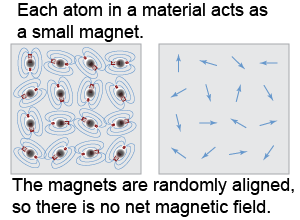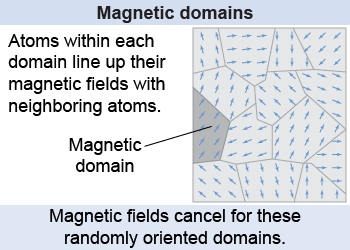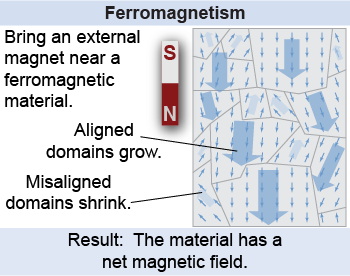|
Most materials have a small response to magnetic fields. Silver, lead, and copper slightly repel magnets of either polarity. This effect is called diamagnetism. Aluminum, magnesium, and tungsten slightly attract magnets of either polarity. These materials are called paramagnetic. In both cases the forces are so small that it takes sensitive instruments to detect them. 
Some materials such as iron, however, are strongly attracted to magnets of either polarity. Your fingers can easily feel the attraction of a steel paper clip to a magnet. Iron, cobalt, and nickel belong to a special class of ferromagnetic materials. Ferromagnetic substances become magnetized and experience strong magnetic forces in the presence of external magnets. 
|
 The magnetic properties of matter come from the magnetic properties of atoms. Each atom acts as a tiny magnet. In most materials the orientation of the atoms is random, so the atomic magnetic fields cancel each other out. In permanent magnets, however, the atoms are, on average, slightly more aligned in one direction than all others. This partial alignment explains why there are permanent magnets.
The magnetic properties of matter come from the magnetic properties of atoms. Each atom acts as a tiny magnet. In most materials the orientation of the atoms is random, so the atomic magnetic fields cancel each other out. In permanent magnets, however, the atoms are, on average, slightly more aligned in one direction than all others. This partial alignment explains why there are permanent magnets. 
|
 The property that makes iron ferromagnetic is that it only takes a small amount of energy for an iron atom to flip its magnetic axis. Groups of iron atoms form magnetic domains. The atoms within a single domain have a similar magnetic alignment. Magnetic domains are small, from 10−6 to 10−4 m. In unmagnetized iron, adjacent domains are randomly scrambled, leaving an overall average magnetic field of zero.
The property that makes iron ferromagnetic is that it only takes a small amount of energy for an iron atom to flip its magnetic axis. Groups of iron atoms form magnetic domains. The atoms within a single domain have a similar magnetic alignment. Magnetic domains are small, from 10−6 to 10−4 m. In unmagnetized iron, adjacent domains are randomly scrambled, leaving an overall average magnetic field of zero. 
|
 When an external magnet is brought near iron, magnetic domains attracted to the external magnet gain atoms and grow because iron atoms can easily change their magnetic orientation. Domains repelled by the external magnet lose atoms and shrink. The migration of atoms into attractive domains quickly magnetizes a volume of iron to attract either pole of the external magnet. Ferromagnetic materials are crucial to many technologies such as motors and generators.
When an external magnet is brought near iron, magnetic domains attracted to the external magnet gain atoms and grow because iron atoms can easily change their magnetic orientation. Domains repelled by the external magnet lose atoms and shrink. The migration of atoms into attractive domains quickly magnetizes a volume of iron to attract either pole of the external magnet. Ferromagnetic materials are crucial to many technologies such as motors and generators. 
| |
| |
|

